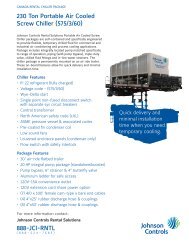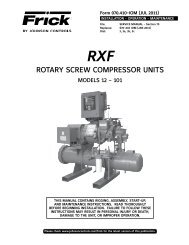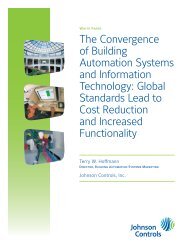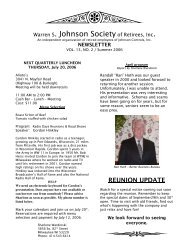Generation Y and the Workplace Annual Report 2010 - Haworth
Generation Y and the Workplace Annual Report 2010 - Haworth
Generation Y and the Workplace Annual Report 2010 - Haworth
You also want an ePaper? Increase the reach of your titles
YUMPU automatically turns print PDFs into web optimized ePapers that Google loves.
60<br />
Photographer: Oriane Pesquier<br />
Global WorkPlace Innovation<br />
Behind Creativity & Productivity<br />
Results:<br />
One of <strong>the</strong> least understood implications of<br />
<strong>the</strong> shift from an industrial to a service-based<br />
design <strong>and</strong> knowledge economy is that <strong>the</strong><br />
physical workplace is becoming a key resource<br />
in leveraging conversations, social learning,<br />
collaboration <strong>and</strong> contemplation. Architects,<br />
facilities managers, <strong>and</strong> furniture suppliers are<br />
leading <strong>the</strong> charge in recognising that workplace<br />
design influences performance. Strategic HR is<br />
beginning to underst<strong>and</strong> <strong>the</strong> role of <strong>the</strong> workplace<br />
<strong>and</strong> workplace design in new ways of working 39 .<br />
We all know from personal experience that<br />
<strong>the</strong> quality of air <strong>and</strong> lighting in a workplace<br />
can influence productivity. As <strong>the</strong> need for<br />
effectiveness in complex social interactions<br />
replaces <strong>the</strong> efficiency dem<strong>and</strong>s of routine<br />
work, <strong>the</strong> psycho-social aspects of <strong>the</strong> working<br />
environment become significant in influencing<br />
productivity. Layout of primary spaces,<br />
provision of common areas, <strong>and</strong> meeting <strong>and</strong><br />
learning spaces mediate our ability to interact<br />
with colleagues in a visually <strong>and</strong> emotionally<br />
stimulating environment 40&41 .<br />
Measuring productivity is notoriously challenging.<br />
Isolating <strong>the</strong> contribution of workplace design<br />
characteristics from o<strong>the</strong>r elements of productivity<br />
is not easy. There are suggestions that ‘knowledge<br />
<strong>and</strong> underst<strong>and</strong>ing of productivity <strong>and</strong> workplace<br />
design is its infancy’. Even so, <strong>the</strong>re is accumulating<br />
evidence that workplace design impacts positively<br />
on workforce performance 42 .<br />
Copyright © <strong>2010</strong>, Johnson Controls. Confidential. All Rights Reserved.<br />
Intellectual Property Johnson Controls, <strong>Haworth</strong> <strong>and</strong> iDEA.<br />
What is productivity <strong>and</strong> how does it differ from<br />
performance? There is twenty years of research on<br />
high-performance work systems centred around<br />
organisational structures, systems <strong>and</strong> processes,<br />
which all function toge<strong>the</strong>r to create environments<br />
that energise workforce competence 33&34 . This is<br />
consistent with CEO responses in recent global<br />
surveys. They said that business model innovation,<br />
creating organisational capabilities to engage<br />
in strategic partnerships <strong>and</strong> collaboration, <strong>and</strong><br />
availability of talented people are top priorities for<br />
<strong>the</strong>m in <strong>the</strong>se difficult business conditions 45 .<br />
The physical workplace is now a crucial additional<br />
component to <strong>the</strong> high-performance work mix.<br />
Environments for generating human capital are<br />
created by job design, support for continuous<br />
learning, challenging <strong>and</strong> meaningful work, <strong>and</strong> fair<br />
reward. We have already noted that workplace design<br />
can shape <strong>and</strong> influence work flows through layout<br />
<strong>and</strong> spaces for different work modes. Organisational<br />
sub-cultures can be so deeply engrained that colocation<br />
does not prevent silo behaviour. Job design,<br />
specifying joint responsibilities across cultural<br />
boundaries, can be used to augment workplace<br />
design to encourage collaboration.<br />
According to <strong>the</strong> respondents, creativity in <strong>the</strong><br />
workplace is triggered mostly by <strong>the</strong> individuals<br />
around you <strong>and</strong> your surrounding area, <strong>the</strong><br />
workplace <strong>and</strong> its ambiance <strong>and</strong> atmosphere. The<br />
technology support is also nowadays essential <strong>and</strong><br />
becomes <strong>the</strong> third most important ingredient in<br />
<strong>the</strong> recipe of creativity at work.<br />
61










![[PDF] Intelligent Fire Annunciator IFA-1000 - Johnson Controls Inc.](https://img.yumpu.com/7424420/1/190x245/pdf-intelligent-fire-annunciator-ifa-1000-johnson-controls-inc.jpg?quality=85)





